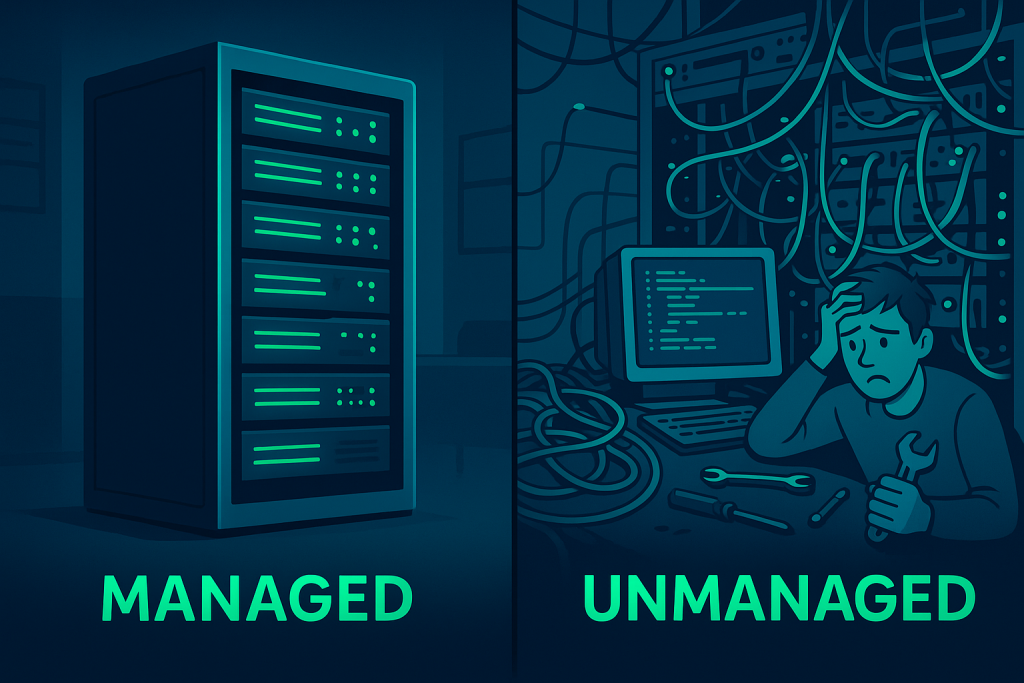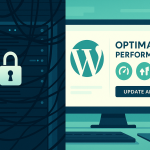If you’ve ever started a website, you know that choosing the right host feels like the first giant hurdle. You hear terms like “shared,” “VPS,” and “dedicated,” and then, on top of all that, you have to decide if you want your hosting to be Managed or Unmanaged.
For a WordPress user, this decision is perhaps the most critical one you’ll make, second only to choosing your domain name. It’s not just about cost; it’s about control, security, speed, and, most importantly, how you spend your time.
This isn’t a quick guide. This is a deep dive, written by a hosting expert, to genuinely help you understand what each path means for your website, your wallet, and your peace of mind. By the time you finish this, you will know exactly which type of hosting is the perfect fit for your specific needs, skill level, and goals.
1. Defining the Battlefield: The Core Difference
At its heart, the difference between Managed and Unmanaged WordPress hosting boils down to a single question: Who is responsible for the server?
Imagine you bought a house.
- Managed Hosting is like living in a luxury condo. You pay a higher monthly fee, but the building management handles everything: the roof repairs, the security gates, the landscaping, the plumbing issues—they even change your furnace filter. You just worry about decorating your specific unit (your content) and enjoying your life.
- Unmanaged Hosting is like owning a fixer-upper farmhouse. You buy the land and the basic structure for a low price. You have total freedom to install any system you want (plumbing, electrical, security), but if the roof leaks at 3 AM, the only person you can call is yourself.
Now, let’s apply this directly to your WordPress website.
1.1. 🏡 What is Managed WordPress Hosting?
Managed WordPress Hosting is a premium service where the hosting provider takes care of all the technical administration of your server and the WordPress core installation. The environment is specifically built and optimized for WordPress alone.
The Host Handles (The “Management”):
- Server Setup & Maintenance: Installing the necessary software (like Apache, Nginx, PHP, MySQL), configuring it for optimal performance, and keeping the operating system updated.
- WordPress Updates: Automatically updating the WordPress core software, often with a staging environment to test the update first.
- Security & Monitoring: Proactive malware scanning, setting up a firewall, patching vulnerabilities, and continuous server monitoring to detect threats before they cause damage.
- Performance Optimization: Implementing specific speed enhancements like advanced, server-side caching, image optimization tools, and integrating with a Content Delivery Network (CDN) to make your site fast globally.
- Backups: Daily, automated backups that are stored off-site (meaning they aren’t on the same server as your website), often with one-click restore functionality.
- Expert Support: Access to a dedicated support team that understands WordPress inside and out. They can help you diagnose a slow plugin, a white screen of death, or a database error—not just general server issues.
1.2. 🛠️ What is Unmanaged Hosting?
Unmanaged hosting (often a traditional VPS or Dedicated Server) gives you a bare-bones server. The host’s responsibility ends after they hand you the keys (root access) and the operating system is installed.
You Handle (The “Unmanaged” Responsibility):
- Server Setup & Configuration: Installing the web server software (Apache, Nginx), the programming language (PHP), the database (MySQL/MariaDB), and a control panel (like cPanel or Plesk, if you want one).
- Server Security: Installing and configuring firewalls, setting up security protocols (like SSH key authentication), patching operating system vulnerabilities, and manually monitoring logs for suspicious activity.
- Optimization: Manually configuring caching mechanisms (like Memcached or Redis), optimizing database settings, and setting up a CDN yourself.
- Updates: Running system updates, WordPress core updates, and database updates—and ensuring nothing breaks in the process.
- Backups: Setting up your own reliable, automated backup system (often requiring third-party software or complex scripts) and ensuring the backup files are stored securely off the server.
- Troubleshooting: Diagnosing and fixing nearly all server and site-level issues yourself. Support is usually limited to hardware failure or basic network connection problems.
2. A Deep Dive into the Trade-Offs
The choice between Managed and Unmanaged is a direct trade-off between Time & Skill versus Cost & Control.
| Feature | Managed WordPress Hosting | Unmanaged Hosting (VPS/Dedicated) |
| Price | Higher (Starting ∼$20 – $35+/month) | Lower (Starting ∼$5 – $15+/month) |
| Ease of Use | Extremely Easy (Hands-Off) | Very Difficult (Requires Advanced Technical Skills) |
| Performance | Highly Optimized for WordPress (Server-side caching, dedicated resources) | Fully Dependent on Your Configuration Skills |
| Security | Proactive, Server-level firewall, Malware detection and removal included. | Your Responsibility. Requires constant monitoring and patching. |
| Support | Expert, WordPress-specific Support (They troubleshoot plugin issues, too) | Limited, Server-Only Support (They won’t help with WordPress errors) |
| Customization | Low to Moderate (You are limited to the host’s optimized “stack”) | High/Unlimited (You have full root access) |
| Time Investment | Very Low (Focus on content and business) | Very High (Requires weekly maintenance and monitoring) |
2.1. The Cost Illusion: Beyond the Monthly Bill
The biggest draw of Unmanaged hosting is the cheap sticker price. A quality unmanaged VPS might cost you $10/month, while a comparable Managed WordPress plan starts at $30/month. That looks like a $240 annual saving.
However, the cost of Unmanaged is often a hidden, expensive iceberg:
1. The Cost of Security Failure
If your unmanaged server is hacked due to an unpatched vulnerability, the cost to hire a security expert to clean and secure your site can easily run $300 to $1,000+. On a Managed plan, cleanup is typically included for free.
2. The Cost of Your Time
If you spend 5 hours a month managing server updates, tuning caching, and monitoring logs on your unmanaged server, and you value your time at just $25/hour, that’s $125/month in hidden labor costs. The Managed plan suddenly looks much cheaper.
3. The Cost of Third-Party Tools
On an unmanaged server, you will likely need to purchase:
- A premium backup service (e.g., UpdraftPlus Premium or VaultPress).
- A premium security plugin (e.g., WordFence Premium or Sucuri).
- A premium performance/caching plugin.
- A user-friendly control panel (e.g., cPanel license).
- Total Annual Cost: $150 – $300 extra, which is often all included in the Managed hosting price.
Expert Takeaway: For most non-technical users, the total true cost (bill + time + tools + risk) of Unmanaged hosting is often higher than the simple monthly fee of Managed hosting.
2.2. The Performance Advantage: Why Managed is Faster
Many people assume they can “tune” an unmanaged server better than a host. While technically possible, Managed hosts dedicate their entire infrastructure to one single purpose: running WordPress fast.
- Server Stack Optimization: Managed hosts use specific, high-performance web servers (like Nginx or LiteSpeed) optimized for PHP (the language WordPress uses) and integrate them with high-speed caches (Redis, Varnish) at the server level. This is infinitely faster than any plugin-based caching you can install on a generic server.
- Resource Isolation: Even when running on a shared infrastructure (like Managed Shared or Managed VPS), resources are carefully isolated, preventing “noisy neighbor” issues where one site hogs resources and slows yours down.
- Built-in CDN: Almost all Managed plans include a global Content Delivery Network (CDN) right out of the box, ensuring your website loads quickly for visitors anywhere in the world without complex setup.
3. The Definitive “Who Should Choose What” Breakdown
The decision is less about Managed vs. Unmanaged and more about User Profile A vs. User Profile B.
3.1. ✅ You Should Choose MANAGED WordPress Hosting If You Are…
1. The Business Owner/Blogger: Your priority is your business, content, or product. You are not an IT professional. You don’t want to spend time debugging database errors or patching Linux vulnerabilities. You need a site that just works, and you need someone to call when it doesn’t.
- Need: Peace of mind, maximum uptime, and focus on growth.
- Best Fit: Any serious blog, high-traffic affiliate site, lead generation site, or standard small business website.
2. The E-commerce Store Owner (WooCommerce): Speed and security are non-negotiable for online stores. A second of downtime or slow loading means lost sales. Managed WordPress hosts offer environments specifically tuned for the heavy database queries that WooCommerce requires.
- Need: High-performance, dedicated security, and one-click staging (to test updates before applying them to a live store).
- Best Fit: All small-to-large WooCommerce, EDD, or membership sites.
3. The Agency or Freelancer Managing Client Sites: As an agency, your reputation relies on your client’s site performance and reliability. Managed hosting provides a reliable platform, standardized tools (staging, migration), and, critically, a professional support team to handle emergencies that you don’t have the bandwidth for.
- Need: Scalability, standardized environment, and white-glove support.
- Best Fit: Web design and development agencies.
4. The Beginner or Intermediate WordPress User: If the terms “SSH,” “Linux,” “NGINX config,” or “Root Access” make your head spin, Managed hosting is your safety net. It simplifies the entire technical process.
- Need: User-friendly dashboard, automated tasks, and accessible expert help.
- Best Fit: Anyone launching their first website.
3.2. ⚠️ You Should Choose UNMANAGED Hosting (VPS/Dedicated) If You Are…
1. The Linux SysAdmin / Experienced Developer: You live and breathe the command line. You have advanced knowledge of Linux, server security, networking, and WordPress optimization. You genuinely enjoy managing the server environment.
- Goal: Maximum control and ability to customize every line of configuration.
- Best Fit: Senior developers, system administrators, or companies with a dedicated in-house IT team.
2. The User with Extremely Specific Technical Requirements: Your application requires a very specific, non-standard technology stack (e.g., a specific, older version of PHP, a particular database configuration, or custom server modules) that no managed host offers.
- Goal: Total flexibility to install and configure non-standard software.
- Best Fit: Highly specialized web applications or very large, custom corporate internal platforms.
3. The Hobbyist Seeking the Absolute Lowest Monthly Bill (with High Risk): You have very little traffic, the site is purely for personal use, and you are willing to spend significant time learning server maintenance to save a few dollars. Crucially, the success or failure of this site will have zero financial impact on you.
- Goal: Cost savings only.
- Best Fit: Personal learning projects, test servers, or low-stakes portfolio sites.
4. Final Verdict and Your Next Step
The truth is, for the vast majority of WordPress users—over 95% of bloggers, small businesses, and e-commerce stores—Managed WordPress Hosting is the superior choice.
It eliminates stress, saves you dozens of hours of technical labor annually, and provides a platform that is almost guaranteed to be faster and more secure than what an individual can set up alone. The added cost is a worthwhile investment in the reliability and future of your business.
Your Next Step:
- Honestly Assess Your Skills: If you can’t confidently perform a basic security audit or troubleshoot a 500 server error using log files, choose Managed.
- Prioritize Your Time: If your time is better spent creating content, selling products, or acquiring clients, choose Managed.
- Don’t Fall for the Cheap Price: Remember the true cost equation: (Monthly Bill) + (Value of Your Time) + (Risk of Downtime/Hack) = True Cost. For Unmanaged, this number is often shockingly high.
Choose the path that allows you to focus on your website’s purpose, not its plumbing. Your business—and your sleep—will thank you for it.



